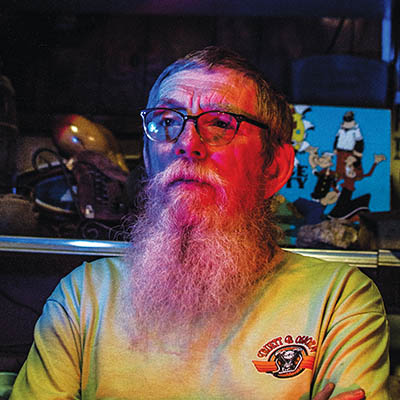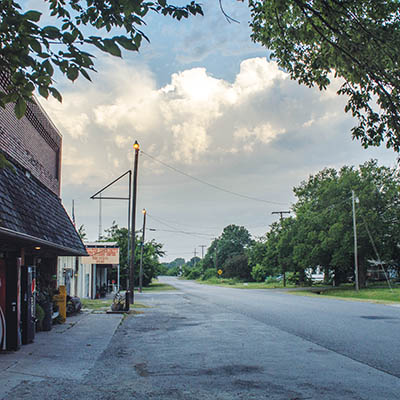Darkness on the edge of town
In Terlton, all is forgiven but nothing forgotten
Terlton from FIRETHIEF on Vimeo.
Just as dusk slipped into darkness on July 4, 2016, Jon Harrod stood on the roof of his Terlton Grocery store, about 30 miles west of Tulsa, and caught a glimpse of his wife, Latina Rose. He saluted goodbye to an orange, green, and silver blaze at the 18th annual Terlton Fireworks Show.
Only about 50 of the 1,000 people parked on quilts and lawn chairs knew the last of Latina’s cremation ashes just winked across the sky on that Independence Day—one of her favorite holidays since childhood. She didn’t want an announcement about the “heavenly flight” that the couple had talked about for years, even before her cancer diagnosis.
“We always said we wanted some of our ashes put into a firework because we love them. A friend shot it off for me from the ground because I needed to be on the roof to light the other fuses,” Harrod said. “I had a show to put on.”
 Moments earlier when 8,000 firecrackers kicked off the celebration, Sally Murphy stepped away from her firework stand—the town’s only one—and watched her good friend’s final wish sparkle and fade. Together in 1998 along with resident Kay Tilley, Sally and Latina had organized a fireworks show. They wanted to lift this community of less than 100 people out of a darkness and self-imposed ban on fireworks that began on June 25, 1985, when the locally owned Aerlex Corporation fireworks plant exploded and killed 21 friends and neighbors.
Moments earlier when 8,000 firecrackers kicked off the celebration, Sally Murphy stepped away from her firework stand—the town’s only one—and watched her good friend’s final wish sparkle and fade. Together in 1998 along with resident Kay Tilley, Sally and Latina had organized a fireworks show. They wanted to lift this community of less than 100 people out of a darkness and self-imposed ban on fireworks that began on June 25, 1985, when the locally owned Aerlex Corporation fireworks plant exploded and killed 21 friends and neighbors.
Streets of fire
With the first boom on that 1985 day, people in communities surrounding Terlton looked toward the sky as a grim cloud rose over the countryside. Cattle scattered to the hills. Songbirds hushed. Neighbors jumped into their pickup trucks and cars in a mad rush to the remote location just west of town. No one had to ask what happened. Everyone within miles knew the fireworks plant—packed with explosives for its busiest day of the year—had exploded.
Most people died instantly. False reports drifted into town within minutes that no one survived, and the people who didn’t drive to the scene gathered at the Terlton Grocery, owned then by Charlotte Johnson and her husband, Alan, who also owned the firework plant. It didn’t take long to learn that out of 26 workers, only five people survived, including Alan, who was badly injured and lost his stepson.
Renee Randall, the Johnsons’ niece, had assembled fireworks at the plant for 10 years along with her mother, Fran Small. The day before, her mother had dropped by and told her not to come to work that next day. Although she was only four miles southwest of the plant, she never heard the explosion. She still wonders why. A preacher came to her house to deliver the news. She drove her truck to the site and busted through the law enforcement roadblock.
“I said, ‘My mom’s in there,’ and they said, ‘You’re not going in,’ ” Randall recalled. “I put my truck in first gear, and I floored it. One of the highway patrolmen went on the hood, the other went through the window. I went out the other side and I took off running. OSHA (Occupational Safety and Health Administration) picked me up at the railroad tracks, which is about a mile in.”
Randall said OSHA officials told her the law enforcement had asked them to bring her back, but she stood firm until they relented and escorted her to where she could see what once was Terlton’s most lucrative employment opportunity.
“When I topped the hill and saw the plant, I knew my mother was gone,” she said. “By the grace of God, my mother died instantly. She didn’t suffer. I also lost my cousin Dean. All of us were like family. That’s when Terlton died.”
For the second time in her life, Randall had survived an explosion. She had been at work in 1979 when a small explosion blamed on spilled black powder ignited and rocked the plant but didn’t kill anyone.
“I still have scars on my chest where my bra had burnt to my breast,” she said. “Alan always preached just run to the expressway if there is an explosion, so that’s what we did in 1979. There wasn’t time to run in ’85. My mother had enough time to look up and gasp—that’s it.”
Louise Whittenburg, 83, lost her nephew, Jason Creekmore, and sister-in-law, Elvera Potts, in the explosion. Survivor’s guilt coupled with constant grief and funeral planning crippled the community. Nearly half of the victims were buried in the Terlton Cemetery. Everyone felt numb.
Several weeks later, Whittenburg saw something that renewed her hope that Terlton would come through the devastating time.
“This kid who lived up on the corner over by the schoolhouse had a horse, and one day he came walking down there leading his horse toward the creek, and he was singing a country song,” Whittenburg said. “I thought, you know, we’re going to come back alive again.”
Bill Hickson, who did part-time mowing and maintenance work at Aerlex, lost his wife, Toni Hickson, and brother, Jesse Hickson. He didn’t go to the plant that day because of a foot problem. He was at his parents’ place watching his dad bring in a harvest of roasting corn when he heard the roar and saw the mushroom cloud fill the sky. He drove 70 mph on five miles of mostly gravel road to reach the site. As soon as he saw the empty hill hovered above the plant located in the valley below, his heart sank.
“I knew if anyone had survived uninjured, they would have made it to the top of that hill,” he said.
In the days that followed, he attended 15 funerals and dealt with the somber knowledge that in the caskets, remains of his family members and friends were “all mixed together because in the end there was very little but dust left.”
He fled town that first July 4 and couldn’t find enough peace to celebrate Independence Day with much joy until the past few years. Patriotism eventually won him back over.
“These people who died at that fireworks plant were some of the proudest Americans that ever got killed,” Hickson said. “They died making something beautiful that we use to celebrate our country’s independence.”
The brokenhearted
Those feelings echo the emotions felt by Terlton Day organizers who eased the community back into a July 4th mood with a small event that now attracts more than 1,000 people and unites surrounding rural communities. Still, the revival took time.
“Our lights went out on June 25, 1985, and they stayed out for a long time,” Murphy said. “It’s a scar that went so deep that it eventually melded everyone together.”
Her mother, Joyce Orcutt, had wrapped her arms and prayers around the Terlton community in the days following the tragedy. She attended 19 funerals within a week and delivered comfort with her legendary home cooking.
“My mom could make a hot roll that could float you to heaven,” Murphy said.
After 13 years of mourning those killed and the loss of her own mother to cancer, Murphy decided Terlton needed a spirit lifter, a patriotic boost, a Fourth of July.
She sold a few fireworks in her yard for a year to test how the community would feel about it. Kids who knew nothing about the tragedy grinned while lighting Black Cat fireworks and coughed through clouds created by smoke bombs. As fountain cones gushed pink, purple, and yellow sparks across the neighborhood lawns, people ooh-ed and aah-ed their sighs of enjoyment and relief while the town’s children danced in the glow.
No one complained, so Murphy sold a few more the next year. Eventually, people started gathering at Terlton Grocery to watch fireworks shot off from the store roof. The annual Terlton Day—a one-day event formerly held in June—linked to the holiday. People started collecting money and cans to buy even more fireworks the next year. The Fourth of July was here to stay.
Prove it all night
With 33 registered voters, 72 water meters, and a census count of 106 people that no one really believes, Terlton—all .02 square miles of it—had always been the kind of “up by” community that people tend to lock onto as more of a geographical reference than a place to visit. Deer hunters and Cimarron River catfish finders hoard their secret hidey-holes by saying, “Oh, it’s up by Terlton,” with few ever driving down its desolate streets.
 No school. No gas station. One church. One tiny grocery/makeshift museum that struggles to survive and sells candy bars, chips, pop, and Anheuser-Busch beer—the only beer that trucks will deliver this far out into Pawnee County.
No school. No gas station. One church. One tiny grocery/makeshift museum that struggles to survive and sells candy bars, chips, pop, and Anheuser-Busch beer—the only beer that trucks will deliver this far out into Pawnee County.
“There are very few photographs of this town from the 1940s, 1950s, or 1960s,” Harrod said. “No one around here had enough money to buy even a $2 Kodak Instamatic.”
June 25, 1985, brought Terlton national attention as one of the worst firework explosions of the time. Despite the tragic circumstances, most people hold no resentment toward Johnson, a Vietnam veteran credited as a pyrotechnic genius, community supporter, and someone who was just trying to help the town out by providing jobs.
Investigators believe the explosions were likely caused when employees unloaded a metal container from a pickup bed where black powder had been spilled. The friction ignited flames that spread onto the nearby buildings. OSHA fines forced Johnson to sell both the grocery store and plant site.
Few local people, if any, blame the tragedy on anything other than an accident. Johnson seldom talks about the incident yet still works in the industry, attends church in Terlton, and has many friends there. When Harrod needed some advice on how to fulfill his wife’s wishes to have her ashes attached to a fireworks shell, he called the most trusted pyrotechnic expert he knew: Alan Johnson.
The town hopes to eventually raise money to create a memorial listing the names of those who died at the plant. For now, they just hope to raise enough money every year to keep the free fireworks show going.
On July 4, 2017, after the games, food, and a parade that has to circle the block several times so participants can throw all of their candy to the crowd, Harrod and a few trusted friends will climb atop the grocery store so they can illuminate the town.
For Terlton, the beauty of black powder is back.
FireThief Productions heads to Terlton July 4 to film the Terlton Day festivities for a new documentary expected to be completed by Spring 2018.
“I think the odds are stacked against people in rural areas,” said filmmaker Sterlin Harjo. “There is a bad perception about people who, like me, were raised in small towns. I love when you can break that down in real time. Terlton’s story kind of speaks to everything that I love about Oklahoma.”
To support the documentary, visit terltonokdoc.com.
Terlton 4th of July fireworks show
Tues., July 4, 7pm–10pm, fireworks begin at dark
50 Main St., Terlton, Oklahoma 74081


.jpg)
.jpg)
